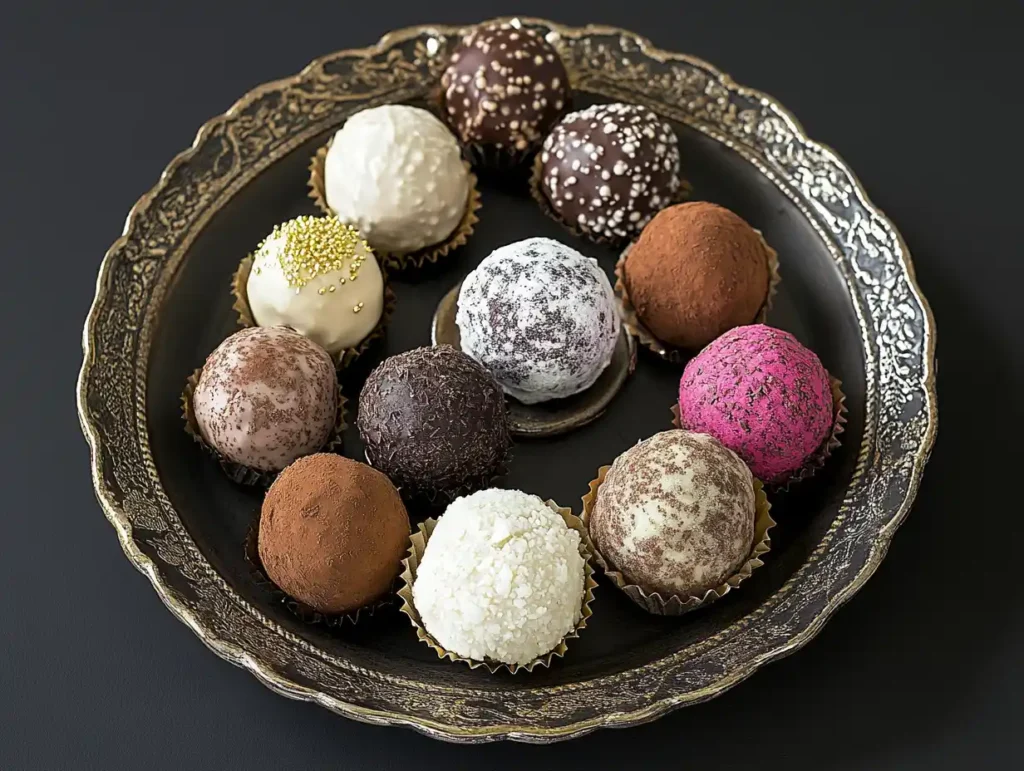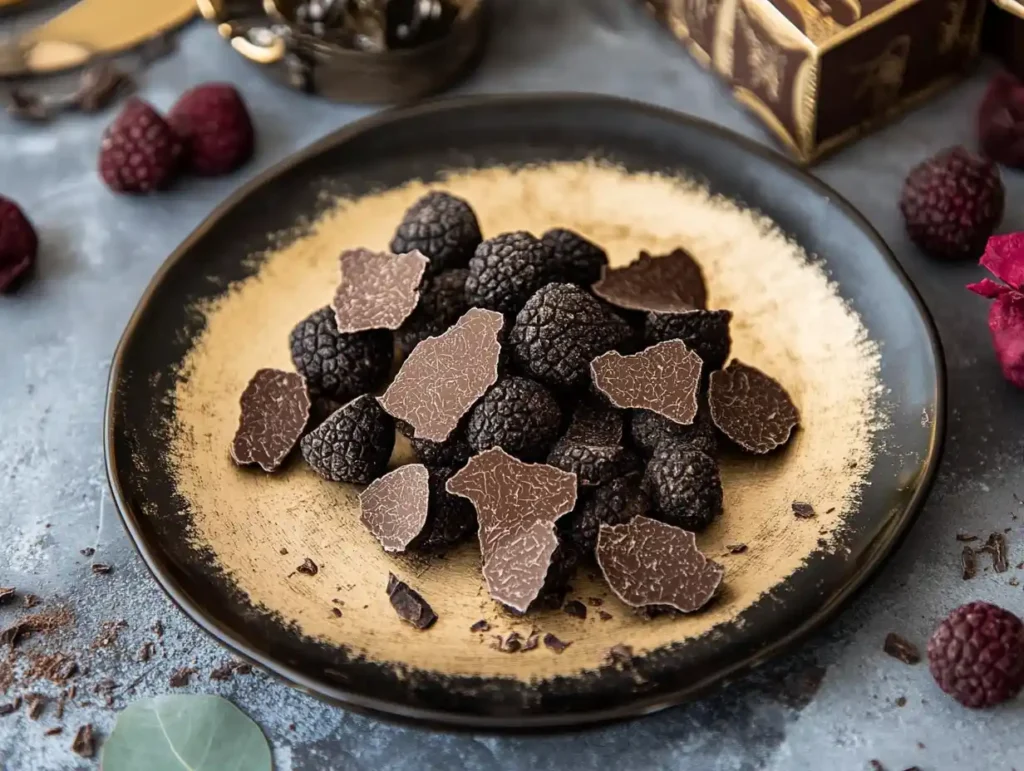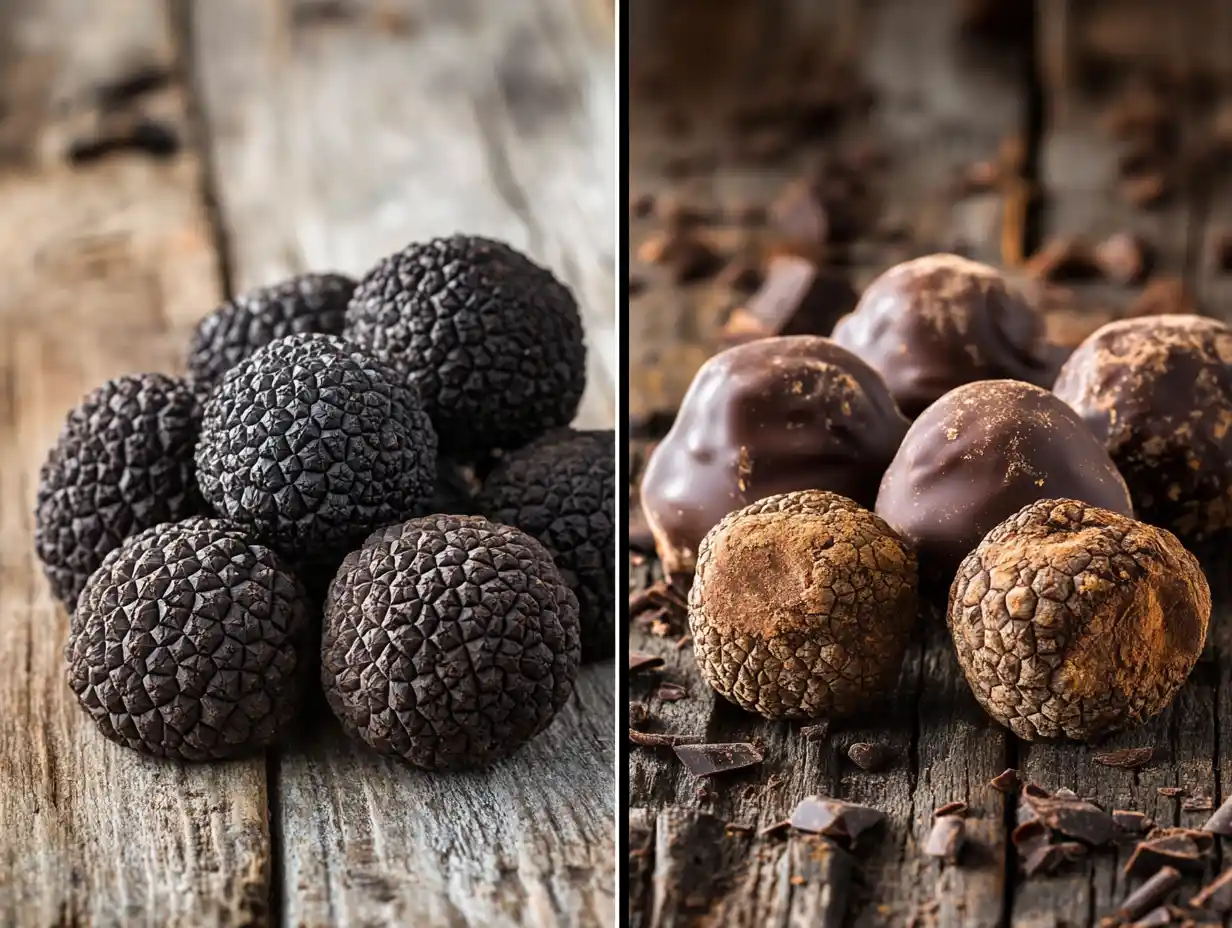Introduction
The culinary world is rich with fascinating terms and ingredients, but few are as often confused as “truffles” and “chocolate truffles.” While they share a name, they are vastly different in origin, composition, and use. This confusion arises mainly from their similar shape and the luxurious connotations both carry.
Understanding the difference between truffles and chocolate truffles is more than a fun fact—it helps appreciate their unique roles in the culinary arts. Whether you’re savoring a creamy, chocolate-filled truffle or encountering the earthy richness of an actual truffle, knowing what distinguishes one from the other can deepen your culinary experience.
In this article, we will explore the origins, characteristics, and cultural significance of truffles and chocolate truffles. We will also answer some frequently asked questions to help clear up any remaining doubts.
What Are Truffles?
Truffles are rare, edible fungi that grow underground, primarily in symbiosis with the roots of specific trees like oaks, hazelnuts, and beeches. These natural treasures have been celebrated for centuries in cuisines worldwide for their distinct earthy aroma and exceptional flavor. Unlike mushrooms that grow above ground, truffles remain hidden, requiring special techniques and tools to harvest them.
Often referred to as the “diamonds of the kitchen,” truffles are one of the most luxurious and expensive ingredients in the culinary world. Their presence on a dish instantly elevates its status, making them a favorite among gourmet chefs and food enthusiasts alike.
Types of Truffles
Truffles come in several varieties, each with its unique characteristics. The most famous and sought-after types include black truffles and white truffles. However, there are also other lesser-known varieties that add diversity to the truffle family.
- Black Truffles: Known as Tuber melanosporum, black truffles have a strong, nutty, and musky flavor profile. Found primarily in regions like France and Italy, they are often incorporated into dishes like pasta, sauces, and meats to add depth and richness. Their season typically lasts from late autumn to early spring.
- White Truffles: Known as Tuber magnatum, white truffles are native to northern Italy, particularly the Piedmont region. Their flavor is more delicate, with a hint of garlic and earthy undertones. Unlike black truffles, white truffles are rarely cooked; instead, they are shaved raw over dishes to release their distinct aroma. They are in season from October to December.
- Summer Truffles: As their name suggests, summer truffles grow during warmer months and have a milder flavor compared to their black and white counterparts. Although more affordable, they still offer a hint of luxury.
- Burgundy Truffles: Similar to summer truffles, these have a slightly stronger taste and are often harvested during the autumn season.
Why Truffles Are So Expensive
The scarcity of truffles is one of the primary reasons behind their high price. Unlike crops that can be planted and harvested on demand, truffles rely on a complex and unpredictable natural ecosystem.
- Difficult Cultivation: Truffles grow underground in a symbiotic relationship with trees, a process that can take several years. Even in controlled environments, truffle farming remains an unpredictable venture.
- Harvesting Challenges: Truffles are located by specially trained animals, typically dogs or pigs, with a keen sense of smell. Harvesters must work diligently to ensure they are carefully unearthed without damage.
- Short Shelf Life: Truffles are highly perishable and need to be consumed fresh to enjoy their full flavor and aroma. This makes storage and transportation costly.
- High Demand, Low Supply: The global appetite for truffles far outweighs their availability. Their use in fine dining establishments and their association with luxury drive prices even higher.
For example, white truffles can fetch prices upward of $4,000 per pound during peak seasons, while black truffles typically cost $800 to $1,500 per pound.
Understanding these factors helps explain why truffles remain a rare treat, reserved for special occasions or high-end dining.
Key Differences Between Truffles and Chocolate Truffles

Understanding the differences between truffles and chocolate truffles can clarify their unique roles in the culinary world. Despite their shared name and association with luxury, they are entirely distinct.
Appearance and Texture
Real truffles have an irregular, knobby shape. Their rough exterior often appears brown or black, depending on the variety. They are firm and dense, with a texture that softens slightly when shaved.
Chocolate truffles are smooth and round. They are usually covered in cocoa powder, chopped nuts, or a hard chocolate shell. Their creamy, melt-in-your-mouth texture comes from their ganache filling.
Flavor Profiles
Truffles have an earthy, musky taste that is hard to describe. Their unique flavor can range from mildly nutty to intensely pungent, depending on the type and freshness. They enhance savory dishes like pasta, risotto, and even eggs.
Chocolate truffles are sweet, with a rich and indulgent flavor. The taste depends on the type of chocolate used, ranging from bittersweet dark chocolate to creamy milk or white chocolate. Additional ingredients, such as caramel or liqueur, add variety.
Production and Sourcing
Truffles grow naturally in specific regions like France, Italy, and Spain. Farmers rely on trained dogs or pigs to locate them. Their growth depends on a delicate balance of soil, climate, and tree symbiosis.
Chocolate truffles are handmade or machine-produced in kitchens and factories worldwide. Their creation doesn’t rely on nature but on the skill and creativity of chocolatiers.
Culinary Uses
Truffles are often shaved or grated over dishes to add a burst of flavor. Chefs pair them with ingredients like butter, cheese, and pasta to enhance their taste.
Chocolate truffles are desserts meant for snacking or gifting. They are enjoyed on their own or used as a garnish for cakes and other sweets.
By comparing these factors, it becomes clear that while truffles and chocolate truffles share a luxurious reputation, their uses and characteristics couldn’t be more different.
The Cultural Significance of Truffles vs. Chocolate Truffles

Truffles and chocolate truffles hold distinct places in food culture. Both symbolize indulgence, but they serve different purposes.
Truffles Elevate Luxury Cuisine
Chefs around the world treasure truffles for their ability to elevate simple dishes. They grate or shave truffles onto pasta, risotto, and eggs to add a burst of earthy flavor. This ingredient has represented opulence since ancient times when only the wealthy could afford them. Today, food enthusiasts attend truffle festivals in places like Alba, Italy, to celebrate their rich history and experience their unmatched taste.
Truffle-infused oils, sauces, and even salts make this delicacy accessible in home kitchens. However, fresh truffles remain a status symbol in fine dining. Their rarity and cost ensure their place as a luxury item.
Chocolate Truffles Bring Joy to Celebrations
Chocolate truffles delight people during special moments. These sweet treats often appear in gift boxes for occasions like birthdays, anniversaries, and Valentine’s Day. Chocolatiers craft truffles in countless flavors, from classic dark chocolate to exotic combinations like chili or champagne-infused ganache.
During the holidays, chocolate truffles become festive staples. Stores wrap them in decorative packaging, making them perfect for sharing or gifting. Their accessibility ensures people can enjoy a touch of sweetness without spending a fortune.
Both Represent Indulgence
Truffles and chocolate truffles share a reputation for indulgence. Chefs use real truffles to create high-end dishes, while chocolate truffles provide rich, satisfying desserts. Both offer moments of pleasure, whether you’re dining at an exclusive restaurant or savoring a treat at home.
Nutritional Differences Between Truffles and Chocolate Truffles
Truffles and chocolate truffles differ not only in flavor and use but also in their nutritional profiles. Understanding these differences can help you appreciate their distinct contributions to your diet.
Truffles’ Nutritional Profile
Truffles are low in calories but rich in essential nutrients. A small serving packs a variety of health benefits:
- Low in Fat: Truffles contain minimal fat, making them a healthy addition to many dishes.
- High in Protein: They offer a surprising amount of protein for a fungus, benefiting vegetarians and those on protein-focused diets.
- Rich in Antioxidants: Truffles provide compounds that fight free radicals and reduce inflammation in the body.
- Source of Vitamins and Minerals: They contain important nutrients like vitamin C, phosphorus, and magnesium, which support overall health.
Despite these benefits, the typical serving size of truffles is small. Their flavor is so strong that chefs use them sparingly, meaning their nutritional impact is subtle but valuable.
Chocolate Truffles’ Nutritional Profile
Chocolate truffles, on the other hand, are indulgent treats that prioritize flavor over nutrition. While they provide energy, they come with some trade-offs:
- High in Calories: A single chocolate truffle can contain 50–100 calories, depending on its size and ingredients.
- Rich in Sugar: The sweetness of chocolate truffles comes from added sugar, which can contribute to weight gain and energy spikes.
- Contains Healthy Fats: Dark chocolate-based truffles may include beneficial fats that support heart health.
- Small Amounts of Minerals: Chocolate contains magnesium, iron, and zinc, but these are present in low amounts.
Enjoy chocolate truffles in moderation to savor their flavor without consuming too much sugar or fat. Choosing dark chocolate varieties can also add a slight nutritional boost.
Key Takeaway
Truffles fit well into health-conscious diets due to their low-calorie and nutrient-rich nature. Chocolate truffles, while delightful, are best reserved as occasional treats. Both offer unique pleasures—one through its gourmet appeal and the other through its sweet decadence.
Frequently Asked Questions (FAQs)
What makes truffles so expensive?
Truffles are expensive because they are rare and challenging to harvest. They grow underground near tree roots and require trained dogs or pigs to find them. Their short growing season, high demand, and delicate handling also contribute to their high price.
Can chocolate truffles contain real truffles?
Some specialty chocolate truffles may include real truffle essence or oil for an earthy flavor. However, most chocolate truffles do not contain real truffles. Instead, they rely on chocolate and other ingredients to create their signature taste.
Do truffles taste like chocolate?
No, truffles do not taste like chocolate. Real truffles have an earthy, musky flavor, completely different from the sweetness of chocolate. The only similarity is their name, which reflects their shared shape and association with indulgence.
Are truffles suitable for vegetarians?
Yes, truffles are suitable for vegetarians. They are fungi and do not involve any animal products in their growth or harvest. However, dishes featuring truffles may include non-vegetarian ingredients, so it’s best to confirm with the chef.
What is the shelf life of chocolate truffles?
Chocolate truffles typically last 1–2 weeks when stored properly. Keep them in a cool, dry place to prevent melting or spoilage. Refrigeration can extend their shelf life, but it may alter their texture slightly.
Where can I buy authentic truffles and chocolate truffles?
You can buy fresh truffles from specialty markets, gourmet food stores, or online retailers during their season. Chocolate truffles are widely available in supermarkets, chocolatiers, and online shops, with both affordable and luxury options to choose from.
Conclusion
Truffles and chocolate truffles may share a name, but they differ in almost every other way. Real truffles, the prized fungi, bring a unique earthy flavor and elevate gourmet dishes with their luxurious appeal. In contrast, chocolate truffles deliver sweet indulgence through creamy ganache and diverse coatings, making them beloved treats for celebrations and everyday enjoyment.
Understanding the differences between these two delicacies adds depth to your appreciation of their unique qualities. Truffles represent nature’s rarity and a chef’s creativity, while chocolate truffles showcase the artistry of chocolatiers and the joy of dessert lovers.
Whether you’re savoring a dish infused with real truffles or biting into a velvety chocolate truffle, each offers an experience worth cherishing. Both capture the essence of indulgence in their own exceptional ways.
If you’re curious about truffles, check out what makes a truffle a truffle for an in-depth look. For festive treats, explore Christmas truffles to add some sweetness to your holiday season. Lastly, learn can you freeze Christmas truffles for tips on preserving these delicacies!

